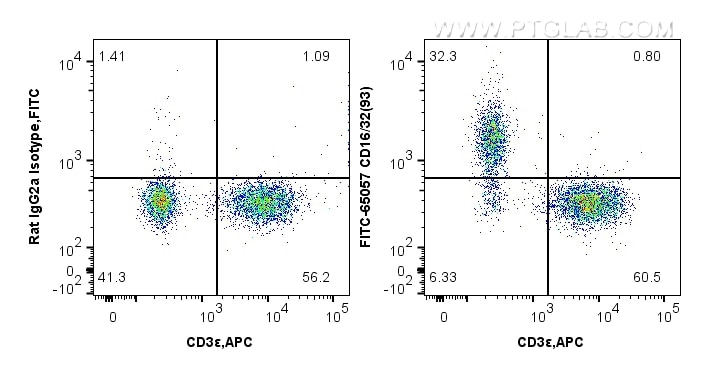Tested Applications
| Positive FC detected in | mouse splenocytes |
Recommended dilution
| Application | Dilution |
|---|---|
| Flow Cytometry (FC) | FC : 0.5 ug per 10^6 cells in 100 μl suspension |
| This reagent has been tested for flow cytometric analysis. It is recommended that this reagent should be titrated in each testing system to obtain optimal results. | |
| Sample-dependent, Check data in validation data gallery. | |
Product Information
FITC-65057 targets CD16/CD32 in FC applications and shows reactivity with mouse samples.
| Tested Reactivity | mouse |
| Host / Isotype | Rat / IgG2a, lambda |
| Class | Monoclonal |
| Type | Antibody |
| Immunogen |
VH81X Tg B cells and T220 stromal cell line Predict reactive species |
| Full Name | Fc receptor, IgG, low affinity IIb |
| GenBank Accession Number | BC038070 |
| Gene Symbol | CD16/32 |
| Gene ID (NCBI) | 14130 |
| RRID | AB_2883747 |
| Conjugate | FITC Plus Fluorescent Dye |
| Excitation/Emission Maxima Wavelengths | 495 nm / 524 nm |
| Form | Liquid |
| Purification Method | Affinity purification |
| UNIPROT ID | P08101 |
| Storage Buffer | PBS with 0.09% sodium azide, pH 7.3. |
| Storage Conditions | Store at 2-8°C. Avoid exposure to light. Stable for one year after shipment. |
Background Information
CD16 (FcγRIII) is a 50-70 kDa low affinity Fc receptor found on the surface of natural killer cells, neutrophil polymorphonuclear leukocytes, monocytes and macrophages. CD16 mediates antibody-dependent cellular cytotoxicity (ADCC) and other antibody-dependent responses, such as phagocytosis. CD32 (FcγRII) is a 40 kD transmembrane glycoprotein that binds to the Fc region of IgG with low affinity. CD32 is present on phagocytic cells such as macrophages and neutrophils, and is involved in the process of phagocytosis and clearing of immune complexes.
Protocols
| Product Specific Protocols | |
|---|---|
| FC protocol for FITC Plus CD16/CD32 antibody FITC-65057 | Download protocol |
| Standard Protocols | |
|---|---|
| Click here to view our Standard Protocols |




